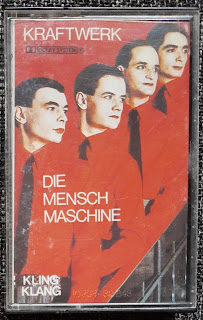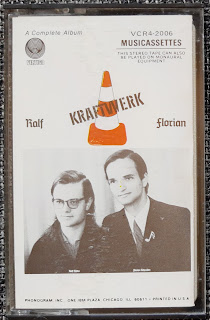DIE MENSCH-MASCHINE (RE, orig. 1978, Germany)
EMI 264 1 32843 4
Internationally, Kraftwerk's legacy is linked to their development of electronic music equipment; equipment which changed the way pop music is made, and of course, a fine legacy per se. But Kraftwerk's influence - in their home country, in other German-language territories and indeed in more far-away places - has at least two more factors of music-changing proportions: Firstly, they were consciously getting away from the blues-based chord progressions, typical in American and English pop music. Songs like Autobahn, The Robots and Tour De France stand out from other pop records of their time because they are electronic, but more because they are written over some exceptional chords. (OK so the "more" here is a matter of taste, bear with me). And secondly, Kraftwerk sang in German at home in Germany. At a time when artists with international aspirations would necessarily sing in English, Kraftwerk took communication seriously enough to sing in their own language at home, paving the way for Die Neue Deutsche Welle and a possibility for pride in the German identity which had been difficult since the mid-40's. (I think this could have been a factor in the rise of own-language new wave music in other places, although who really knows? I'll just throw it in here for now.)
All albums after Radio-Activity came in German versions at home, except Tour De France Soundracks, which was only sung in French. Obviously, this makes the German-language editions indispensable to all Kraftwerk fans, and cassette collectors are no exception. When I started collecting, a full hand of German versions were at the top of my want list, and of course, I kept a keen eye open for any variations.
Die Mensch-Maschine is a fine example of Kraftwerk's keen eye for cassette cover design. Much of the constructivist inspiration of the LP sleeve, with the title and band name at 45 degree angles in the corners, is sacrificed. The information is printed from left to right, and the band image is tightly cropped. At the bottom of most earlier editions, the cat.no. is printed in white, but here, it's rather hastily scratched out; possibly because it is changed from the original to here. Further north, we see the big "Dolby system" logo, which is not on early editions.
I think this is a mid-80s reissue, seeing the "Made in EEC" on the labels. The clear shells with on-body print point in the same direction, although it could be earlier too for what I know. The cassette comes with a simple 1-panel J-card, printed on glossy paper.








Comments
Post a Comment